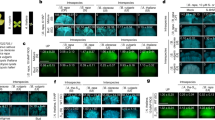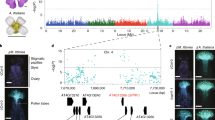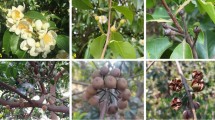Abstract
Self-incompatibility in the Brassicaceae is controlled by multiple haplotypes encoding the pollen ligand (S-locus protein 11, SP11, also known as S-locus cysteine-rich protein, SCR) and its stigmatic receptor (S-receptor kinase, SRK). A haplotype-specific interaction between SP11/SCR and SRK triggers the self-incompatibility response that leads to self-pollen rejection, but the signalling pathway remains largely unknown. Here we show that Ca2+ influx into stigma papilla cells mediates self-incompatibility signalling. Using self-incompatible Arabidopsis thaliana expressing SP11/SCR and SRK, we found that self-pollination specifically induced an increase in cytoplasmic Ca2+ ([Ca2+]cyt) in papilla cells. Direct application of SP11/SCR to the papilla cell protoplasts induced Ca2+ increase, which was inhibited by D-(−)-2-amino-5-phosphonopentanoic acid (AP-5), a glutamate receptor channel blocker. An artificial increase in [Ca2+]cyt in papilla cells arrested wild-type (WT) pollen hydration. Treatment of papilla cells with AP-5 interfered with self-incompatibility, and Ca2+ increase on the self-incompatibility response was reduced in the glutamate receptor-like channel (GLR) gene mutants. These results suggest that Ca2+ influx mediated by GLR is the essential self-incompatibility response leading to self-pollen rejection.
This is a preview of subscription content, access via your institution
Access options
Subscribe to this journal
Receive 12 digital issues and online access to articles
$119.00 per year
only $9.92 per issue
Buy this article
- Purchase on Springer Link
- Instant access to full article PDF
Prices may be subject to local taxes which are calculated during checkout





Similar content being viewed by others
References
Takayama, S. & Isogai, A. Self-incompatibility in plants. Annu. Rev. Plant Biol. 56, 467–489 (2005).
Takayama, S. et al. Direct ligand-receptor complex interaction controls Brassica self-incompatibility. Nature 413, 534–538 (2001).
Iwano, M. et al. Actin dynamics in papilla cells of Brassica rapa during self- and cross-pollination. Plant Physiol. 144, 72–81 (2007).
Samuel, M. A. et al. Proteomic analysis of Brassica stigmatic proteins following the self-incompatibility reaction reveals a role for microtubule dynamics during pollen responses. Mol. Cell Proteomics 10, M111.011338 (2011).
Murase, K. et al. A membrane-anchored protein kinase involved in Brassica self-incompatibility signaling. Science 303, 1516–1519 (2004).
Kakita, M. et al. Two distinct forms of M-locus protein kinase localize to the plasma membrane and interact directly with S-locus receptor kinase to transduce self-incompatibility signaling in Brassica rapa. Plant Cell 19, 3961–3973 (2007).
Takada, Y. et al. Involvement of MLPK pathway in intraspecies unilateral incompatibility regulated by a single locus with stigma and pollen factors. G3 Bethesda 3, 719–726 (2013).
Kitashiba, H., Liu, P., Nishio, T., Nasrallah, J. B. & Nasrallah, M. E. Functional test of Brassica self-incompatibility modifiers in Arabidopsis thaliana. Proc. Natl Acad. Sci. USA 108, 18173–18178 (2011).
Gu, T. et al. Binding of an arm repeat protein to the kinase domain of the S-locus receptor kinase. Proc. Natl Acad. Sci. USA 95, 382–387 (1998).
Stone, S. L., Arnoldo, M. & Goring, D. R. A breakdown of Brassica self-incompatibility in ARC1 antisense transgenic plants. Science 286, 1729–1731 (1999).
Stone, S. L., Anderson, E. M., Mullen, R. T. & Goring, D. R. ARC1 is an E3 ubiquitin ligase and promotes the ubiquitination of proteins during the rejection of self-incompatible Brassica pollen. Plant Cell 15, 885–898 (2003).
Samuel, M. A. et al. Cellular pathways regulating responses to compatible and self-incompatible pollen in Brassica and Arabidopsis stigmas intersect at Exo70A1, a putative component of the exocyst complex. Plant Cell 21, 2655–2671 (2009).
Hsu, S. C., TerBush, D., Abraham, M. & Guo, W. The exocyst complex in polarized exocytosis. Int. Rev. Cytol. 233, 243–265 (2004).
Indriolo, E., Tharmapalan, P., Wright, S. I. & Goring, D. R. The ARC1 E3 ligase gene is frequently deleted in self-compatible Brassicaceae species and has a conserved role in Arabidopsis lyrata self-pollen rejection. Plant Cell 24, 4607–4620 (2012).
Indriolo, E., Safavian, D. & Goring, D. R. The ARC1 E3 ligase promotes two different self-pollen avoidance traits in Arabidopsis. Plant Cell 26, 1525–1543 (2014).
Nasrallah, J. B. & Nasrallah, M. E. Robust self-incompatibility in the absence of a functional ARC1 gene in Arabidopsis thaliana. Plant Cell 26, 3838–3841 (2014).
Goring, D. R., Indriolo, E. & Samuel, M. A. The ARC1 E3 ligase promotes a strong and stable self-incompatibility response in Arabidopsis species: response to the Nasrallah and Nasrallah commentary. Plant Cell 26, 3842–3846 (2014).
Dearnaley, J. D., Levina, N. N., Lew, R. R., Heath, I. B. & Goring, D. R. Interrelationships between cytoplasmic Ca2+ peaks, pollen hydration and plasma membrane conductances during compatible and incompatible pollinations of Brassica napus papillae. Plant Cell Physiol. 38, 985–999 (1997).
Sherman-Broyles, S. et al. S locus genes and the evolution of self-fertility in Arabidopsis thaliana. Plant Cell 19, 94–106 (2007).
Tsuchimatsu, T. et al. Evolution of self-compatibility in Arabidopsis by a mutation in the male specificity gene. Nature 464, 1342–1346 (2010).
Dwyer, K. G. et al. Molecular characterization and evolution of self-incompatibility genes in Arabidopsis thaliana: the case of the Sc haplotype. Genetics 193, 985–994 (2013).
Nasrallah, M. E., Liu, P. & Nasrallah, J. B. Generation of self-incompatible Arabidopsis thaliana by transfer of two S locus genes from A. lyrata . Science 297, 247–249 (2002).
Nasrallah, M. E., Liu, P., Sherman-Broyles, S., Boggs, N. A. & Nasrallah, J. B. Natural variation in expression of self-incompatibility in Arabidopsis thaliana: implications for the evolution of selfing. Proc. Natl Acad. Sci. USA 101, 16070–16074 (2004).
Goring, D. R. & Rothstein, S. J. The S-locus receptor kinase gene in a self-incompatible Brassica napus line encodes a functional serine/threonine kinase. Plant Cell 4, 1273–1281 (1992).
Tantikanjana, T., Rizvi, N., Nasrallah, M. E. & Nasrallah, J. B. A dual role for the S-locus receptor kinase in self-incompatibility and pistil development revealed by an Arabidopsis rdr6 mutation. Plant Cell 21, 2642–2654 (2009).
Sarker, R. H., Elleman, C. J. & Dickinson, H. G. Control of pollen hydration in Brassica requires continued protein synthesis, and glycosylation in necessary for intraspecific incompatibility. Proc. Natl Acad. Sci. USA 85, 4340–4344 (1988).
Nagai, T., Yamada, S., Tominaga, T., Ichikawa, M. & Miyawaki, A. Expanded dynamic range of fluorescent indicators for Ca2+ by circularly permuted yellow fluorescent proteins. Proc. Natl Acad. Sci. USA 101, 10554–10559 (2004).
Iwano, M. et al. Ca2+ dynamics in a pollen grain and papilla cell during pollination of Arabidopsis. Plant Physiol. 136, 3562–3571 (2004).
Shimosato, H. et al. Characterization of the SP11/SCR high-affinity binding site involved in self/nonself recognition in Brassica self-incompatibility. Plant Cell 19, 107–117 (2007).
Gee, K. R. et al. Chemical and physiological characterization of fluo-4 Ca2+-indicator dyes. Cell Calcium 27, 97–106 (2000).
Knight, H., Trewavas, A. J. & Knight, M. R. Calcium signalling in Arabidopsis thaliana responding to drought and salinity. Plant J. 12, 1067–1078 (1997).
Michard, E. et al. Glutamate receptor-like genes form Ca2+ channels in pollen tubes and are regulated by pistil D-serine. Science 332, 434–437 (2011).
Parre, E. et al. Calcium signaling via phospholipase C is essential for proline accumulation upon ionic but not nonionic hyperosmotic stresses in Arabidopsis. Plant Physiol. 144, 503–512 (2007).
White, P. J. Calcium channels in higher plants. Biochim. Biophys. Acta 1465, 171–189 (2000).
Schuh, K. et al. Plasma membrane Ca2+ ATPase 4 is required for sperm motility and male fertility. J. Biol. Chem. 279, 28220–28226 (2004).
Okuda, S. et al. Defensin-like polypeptide LUREs are pollen tube attractants secreted from synergid cells. Nature 458, 357–361 (2009).
Denninger, P. et al. Male–female communication triggers calcium signatures during fertilization in Arabidopsis. Nature Commun. 5, 4645 (2014).
Kerhoas, C., Knox, R. B. & Dumas, C. Specificity of the callose response in stigmas of Brassica. Ann. Bot. 52, 597–602 (1983).
Kauss, H. Callose biosynthesis as a Ca2+-regulated process and possible relations to the induction of other metabolic changes. J. Cell Sci. Suppl. 2, 89–103 (1985).
Price, M. B., Jelesko, J. & Okumoto, S. Glutamate receptor homologs in plants: functions and evolutionary origins. Front. Plant Sci. 3, 1–10 (2012).
Roy, S. J. et al. Investigating glutamate receptor-like gene co-expression in Arabidopsis thaliana. Plant, Cell & Environ. 31, 861–871 (2008).
Iwano, M. et al. A pollen coat–inducible autoinhibited Ca2+-ATPase expressed in stigmatic papilla cells is required for compatible pollination in the Brassicaceae. Plant Cell 26, 636–649 (2014).
Iwano, M. & Takayama, S. Self/non-self discrimination in angiosperm self-incompatibility. Curr. Opin. Plant Biol. 15, 78–83 (2011).
Wheeler, M. J. et al. Identification of the pollen self-incompatibility determinant in Papaver rhoeas. Nature 459, 992–995 (2009).
Wheeler, M. J., Vatovec, S. & Franklin-Tong, V. E. The pollen S-determinant in Papaver: comparisons with known plant receptors and protein ligand partners. J. Exp. Bot. 61, 2015–2025 (2010).
Harada, Y. et al. Mechanism of self-sterility in a hermaphroditic chordate. Science 320, 548–550 (2008).
Saito, T., Shiba, K., Inaba, K., Yamada, L. & Sawada, H. Self-incompatibility response induced by calcium increase in sperm of the ascidian Ciona intestinalis. Proc. Natl Acad. Sci. USA 109, 4158–4162 (2012).
Iwano, M. et al. Fine-tuning of the cytoplasmic Ca2+ concentration is essential for pollen tube growth. Plant Physiol. 150, 1322–1334 (2009).
Shiba, H. et al. Alteration of the self-incompatibility phenotype in Brassica by transformation of the antisense SLG gene. Biosci. Biotechnol. Biochem. 64, 1016–1024 (2000).
Acknowledgements
We thank Y. Ryokume, M. Okamura, F. Yamamoto, and M. Matsumura-Kawashima for their technical assistance. This work was supported in part by Grants-in-Aid for Scientific Research on Innovative Areas (21112003 to M. Iwano; 23113002 to S.T.), Grants-in-Aid for Scientific Research (23570056, 26440145 to M. Iwano; 21248014, 25252021 to S.T.), and Grants-in-Aid for Creative Scientific Research (16GS0316 to A.I.) from the Ministry of Education, Culture, Sports, Science and Technology of Japan (MEXT); and by Grants-in-Aid for JSPS Research Fellow (12J08273 to K.I.) from the Japan Society for the Promotion of Science (JSPS).
Author information
Authors and Affiliations
Contributions
M. Iwano, A.I. and S.T. initiated the project. M. Iwano, K.I., M.K., P.K.-N., T.N., A.M. and S.T. designed experiments. M. Iwano, K.I., H.A.-S., S.F., M. Igarashi, T.E., A.K., M.T., M.T., K.K. and H.S. performed the experiments. M. Iwano, K.I., S.F. and S.T. wrote the manuscript.
Corresponding author
Ethics declarations
Competing interests
The authors declare no competing financial interests.
Rights and permissions
About this article
Cite this article
Iwano, M., Ito, K., Fujii, S. et al. Calcium signalling mediates self-incompatibility response in the Brassicaceae. Nature Plants 1, 15128 (2015). https://doi.org/10.1038/nplants.2015.128
Received:
Accepted:
Published:
DOI: https://doi.org/10.1038/nplants.2015.128
This article is cited by
-
Genetics Behind Sexual Incompatibility in Plants: How Much We Know and What More to Uncover?
Journal of Plant Growth Regulation (2023)
-
Insights into pollen–stigma recognition: self-incompatibility mechanisms serve as interspecies barriers in Brassicaceae?
aBIOTECH (2023)
-
The molecular signatures of compatible and incompatible pollination in Arabidopsis
BMC Genomics (2021)
-
Mechanism of self/nonself-discrimination in Brassica self-incompatibility
Nature Communications (2020)
-
Parallel evolution of dominant pistil-side self-incompatibility suppressors in Arabidopsis
Nature Communications (2020)



